“Infernal Trickster: The Mischievous Imp of Shadow and Flame”
“A sly, winged devil no bigger than a cat, the Imp whispers temptations, strikes unseen, and vanishes in a puff of brimstone before you realize you’ve already made its deal.”
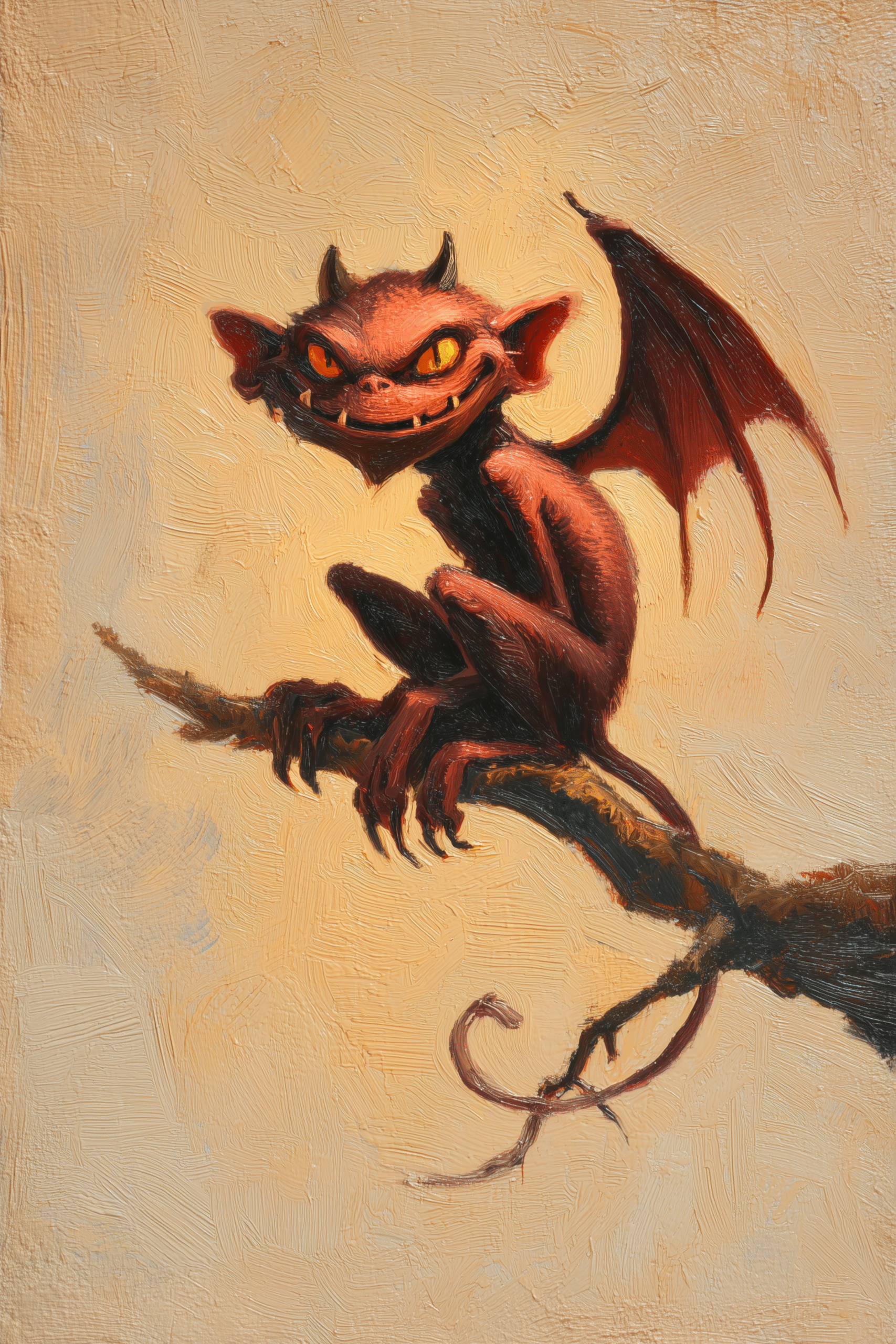
Small, leathery-winged devils no taller than two feet, imps possess wiry, clawed limbs, barbed tails, and skin ranging from sooty black to crimson red. Their eyes glow with sly intelligence, and their fanged grins rarely fade. When motionless, an imp can pass for an infernal gargoyle; when in flight, its rapid, darting movements resemble a bat’s erratic dance.
Behaviour
Imps are opportunistic mischief-makers, blending subtle sabotage with sudden bursts of violence. They enjoy toying with prey and allies alike, often feigning loyalty until betrayal is most advantageous. Patient and observant, they will watch a target for days before making a move, interspersing their schemes with petty pranks and whispered lies.
Habitat
Native to the Nine Hells, imps are most often found lurking in infernal courts, abandoned temples, and mortal cities corrupted by devilish influence. They thrive in places rich with temptation—marketplaces, gambling dens, or anywhere sin festers—and adapt easily to both urban shadows and wild, desolate places.
Modus Operandi
Imps prefer ambush and subterfuge over open combat, relying on invisibility, flight, and venomous stingers to weaken foes before closing in. They may serve as spies, messengers, or assassins for more powerful devils, slipping unnoticed through planar gates. When pressed into battle, they harry from the air, striking at isolated targets before retreating to safety.
Motivation
An imp’s existence is fueled by a hunger for mortal souls and a yearning for infernal promotion. They tempt, corrupt, and manipulate in service to their masters—and to their own ambition—always angling for a bargain that trades mortal weakness for a step up the infernal hierarchy.
Devil, Imp 5e 2024
Devil, Imp 3.5
Imp 3.5
Imp
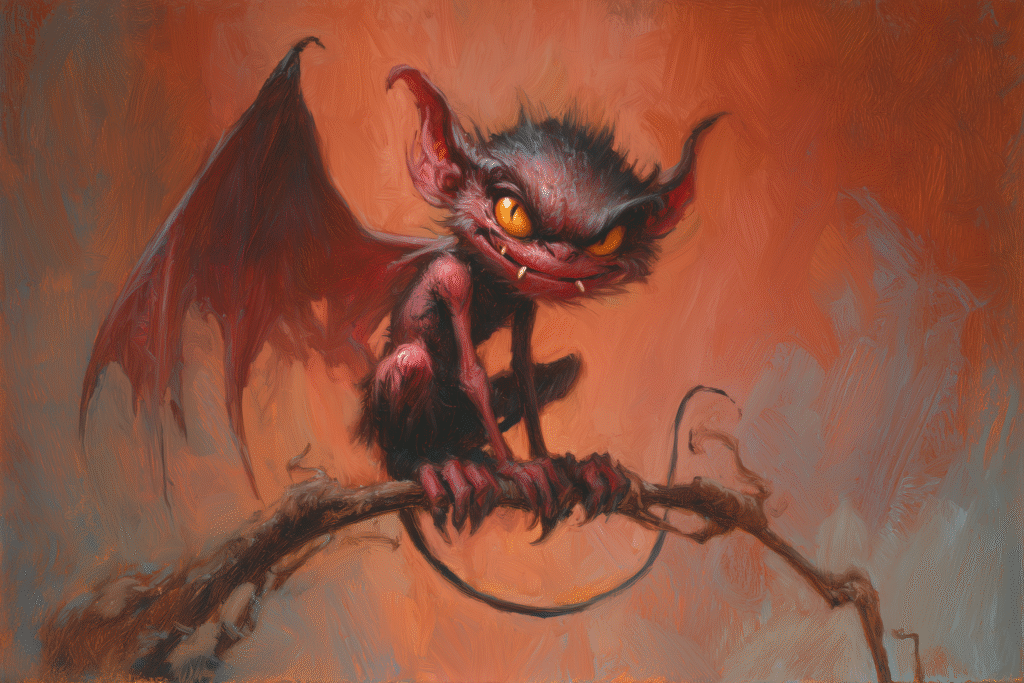
Tiny fiend (devil, shapechanger), lawful evil
Armor Class 14 (natural armor)
Hit Points 27 (6d4 + 12)
Speed 20 ft., fly 40 ft.
| STR | DEX | CON | INT | WIS | CHA |
|---|---|---|---|---|---|
| 6 (–2) | 17 (+3) | 14 (+2) | 11 (+0) | 12 (+1) | 14 (+2) |
Saving Throws Dex +5, Wis +3, Cha +4
Skills Deception +4, Insight +3, Perception +3, Stealth +7
Damage Resistances cold; bludgeoning, piercing, and slashing from nonmagical attacks that aren’t silvered
Damage Immunities fire, poison
Condition Immunities poisoned
Senses darkvision 120 ft. (magical darkness doesn’t impede vision), passive Perception 13
Languages Common, Infernal, telepathy 60 ft.
Challenge 2 (450 XP)
Proficiency Bonus +2
Traits
- Shapechanger. The imp can use its action to polymorph into a raven (speed 20 ft., fly 60 ft.), rat (speed 20 ft., climb 20 ft.), or spider (speed 20 ft., climb 20 ft.), or back into its true form. Its statistics remain the same in each form, except for its movement modes.
- Devil’s Sight. Magical darkness doesn’t impede the imp’s darkvision.
- Magic Resistance. The imp has advantage on saving throws against spells and other magical effects.
- Cunning Corruptor. The imp has advantage on Charisma (Deception) and Charisma (Persuasion) checks made to tempt or manipulate mortals into bargains.
Innate Spellcasting.
The imp’s innate spellcasting ability is Charisma (spell save DC 12, +4 to hit with spell attacks). It can innately cast the following spells, requiring no material components:
- At will: invisibility (self only), thaumaturgy
- 1/day each: charm person, suggestion
Actions
- Multiattack. The imp makes two attacks: one with its Sting and one with its Infernal Taunt (if available), or two Stings.
- Sting (Bite in Beast Form). Melee Weapon Attack: +5 to hit, reach 5 ft., one target. Hit: 5 (1d4 + 3) piercing damage plus 10 (3d6) poison damage, or half poison damage on a successful DC 11 Constitution save.
- Infernal Taunt (Recharge 5–6). The imp magically lashes out with telepathic mockery at a creature it can see within 30 feet. The target must succeed on a DC 12 Wisdom saving throw or be compelled to attack the imp on its next turn, moving as close as possible and using its most damaging attack. This is a magical compulsion effect.
Reactions
- Evasive Flutter. When a creature the imp can see targets it with an attack, the imp can impose disadvantage on the roll by darting unpredictably, provided it is flying.
Legendary Actions (Optional for powerful imps)
The imp can take 1 legendary action per round, choosing from the options below. Only one option can be used at a time and only at the end of another creature’s turn:
- Vanish. The imp uses invisibility.
- Move. The imp flies up to half its speed without provoking opportunity attacks.
Lair Actions (If the imp rules a small domain in the Nine Hells or a corrupted mortal lair)
On initiative count 20 (losing initiative ties), the imp can cause one of the following effects:
- The imp summons a cloud of brimstone smoke in a 10-foot radius centered on a point it can see within 30 feet; the area is lightly obscured and creatures inside must succeed on a DC 11 Constitution save or be poisoned until the start of their next turn.
- Shadows in the lair twist unnaturally; all hostile creatures in dim light or darkness have disadvantage on Wisdom (Perception) checks until initiative count 20 on the next round.
Combat Tactics
Imps are cautious, never engaging unless confident of victory or escape. They prefer to begin encounters while invisible, trailing a target to gather information. In battle, they use flight and small size to stay out of reach, striking with Sting before retreating into darkness. They exploit Devil’s Sight to fight in magical darkness and use Infernal Taunt to lure enemies into traps or away from allies. Against spellcasters, they rely on Magic Resistance and constant movement to avoid control effects. If badly wounded, they turn invisible and disengage, often returning later for revenge.
Devil, Imp
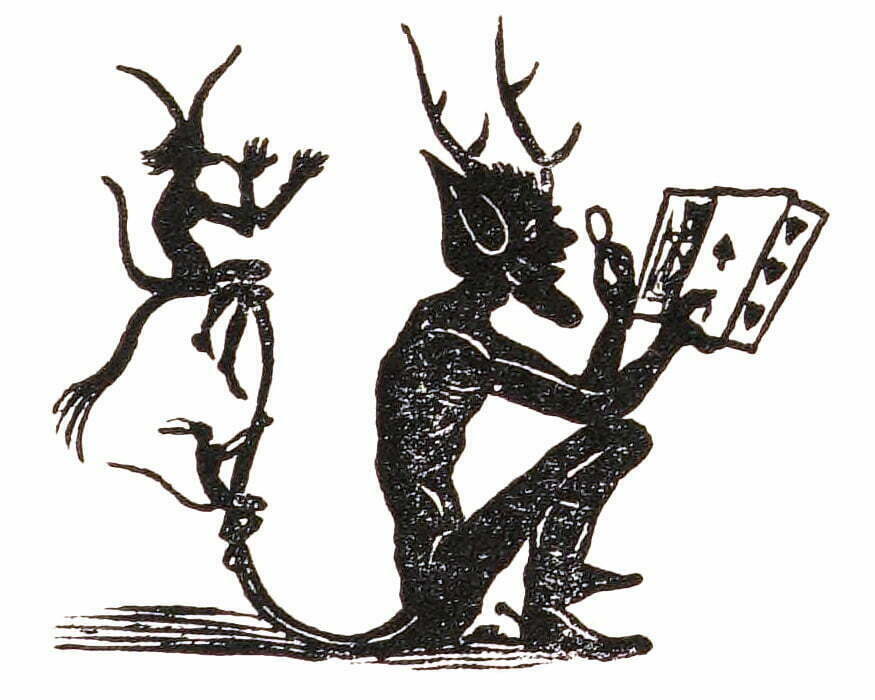
Fiendish wings and a whipping scorpion-like tail lash behind this diminutive, red-skinned nuisance.
Family: Devils
Tiny fiend (devil, shapechanger), lawful evil
Armor Class 13
Hit Points 10 (3d4 + 3)
Speed 20 ft., fly 40 ft.
| STR | DEX | CON | INT | WIS | CHA |
|---|---|---|---|---|---|
| 6 (-2) | 17 (+3) | 13 (+1) | 11 (+0) | 12 (+1) | 14 (+2) |
Skills Deception +4, Insight +3, Persuasion +4, Stealth +5
Damage Resistances cold; bludgeoning, piercing, and slashing from nonmagical attacks that aren’t silvered
Damage Immunities fire, poison
Condition Immunities poisoned
Senses darkvision 120 ft., passive Perception 11
Languages Infernal, Common
Challenge 1 (200 XP)
Special Traits
- Shapechanger: The imp can use its action to polymorph into a beast form that resembles a rat (speed 20 ft.), a raven (20 ft., fly 60 ft.), or a spider (20 ft., climb 20 ft.), or back into its true form. Its statistics are the same in each form, except for the speed changes noted. Any equipment it is wearing or carrying isn’t transformed. It reverts to its true form if it dies.
- Devil’s Sight: Magical darkness doesn’t impede the imp’s darkvision.
- Magic Resistance: The imp has advantage on saving throws against spells and other magical effects.
Actions
- Sting (Bite in Beast Form): Melee Weapon Attack: +5 to hit, reach 5 ft., one target. Hit: 5 (1d4 + 3) piercing damage, and the target must make on a DC 11 Constitution saving throw, taking 10 (3d6) poison damage on a failed save, or half as much damage on a successful one.
- Invisibility: The imp magically turns invisible until it attacks or until its concentration ends (as if concentrating on a spell). Any equipment the imp wears or carries is invisible with it.
Familiar. This creature is an option for spellcasters using the find familiar spell.
Imp
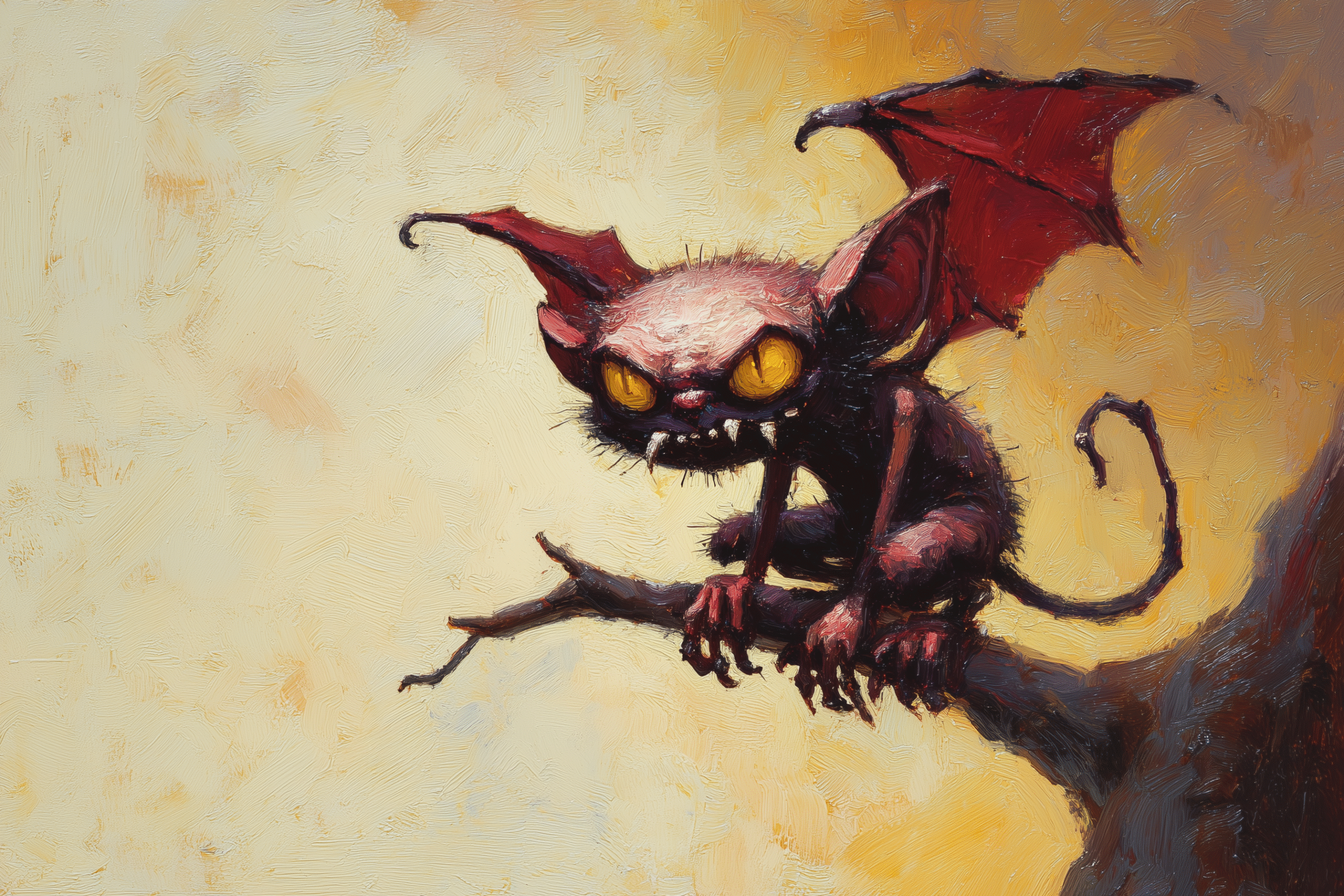
An imp is a mythological being similar to a fairy or demon, frequently described in folklore and superstition.
Imps are usually described as mischievous more than seriously threatening, and as lesser beings rather than more important supernatural beings. The attendants of the devil are sometimes described as imps. They are usually described as lively and having small stature.
Imps are sometimes described as fond of music, and capable of being charmed into making a promise to aid, and “do good” in that manner through music—though there is always likely to be some mischievous trick to be attached to the barter.
Imps were the common name given to familiar spirits that served witches in the Middle Ages. Imps were usually kept inside artifacts such as gemstone pieces or vials and summoned for service by magics. An example of such an imp is one that was supposedly under the service of the alchemist Paracelsus.
In its natural form, an imp stands almost 2 feet tall and weighs about 8 pounds.
Imp
| Imp | |
| Tiny outsider (Evil, Extraplanar, Lawful) | |
| Hit Dice | 3d8 (13 hp) |
| Initiative | +3 |
| Speed | 20 ft. (4 squares), Fly 50 ft. (perfect) |
| Armor Class | 20 (+2 size, +3 Dexterity, +5 natural), touch 15, flat-footed 17 |
| Base Attack/Grapple | +3/–5 |
| Attack | Sting +8 melee (1d4 plus poison) |
| Full Attack | Sting +8 melee (1d4 plus poison) |
| Space/Reach | 2-1/2 ft./0 ft. |
| Special Attacks | Poison, spell-like abilities |
| Special Qualities | Alternate form, damage reduction 5/good or silver, Darkvision 60 ft., fast healing 2, immunity to poison, resistance to fire 5 |
| Saves | Fort +3, Ref +6, Will +4 |
| Abilities | Strength 10, Dexterity 17, Constitution 10, Intelligence 10, Wisdom 12, Charisma 14 |
| Skills | Diplomacy +8, Hide +17, Knowledge (any one) +6, Listen +7, Move Silently +9, Search +6, Spellcraft +6, Spot +7, Survival +1 (+3 following tracks) |
| Feats | Dodge, Weapon Finesse |
| Environment | A lawful evil-aligned plane |
| Organization | Solitary |
| Challenge Rating | 2 |
| Treasure | None |
| Alignment | Always lawful evil |
| Advancement | 4–6 HD (Tiny) |
| Level Adjustment | — (Improved Familiar) |
Combat
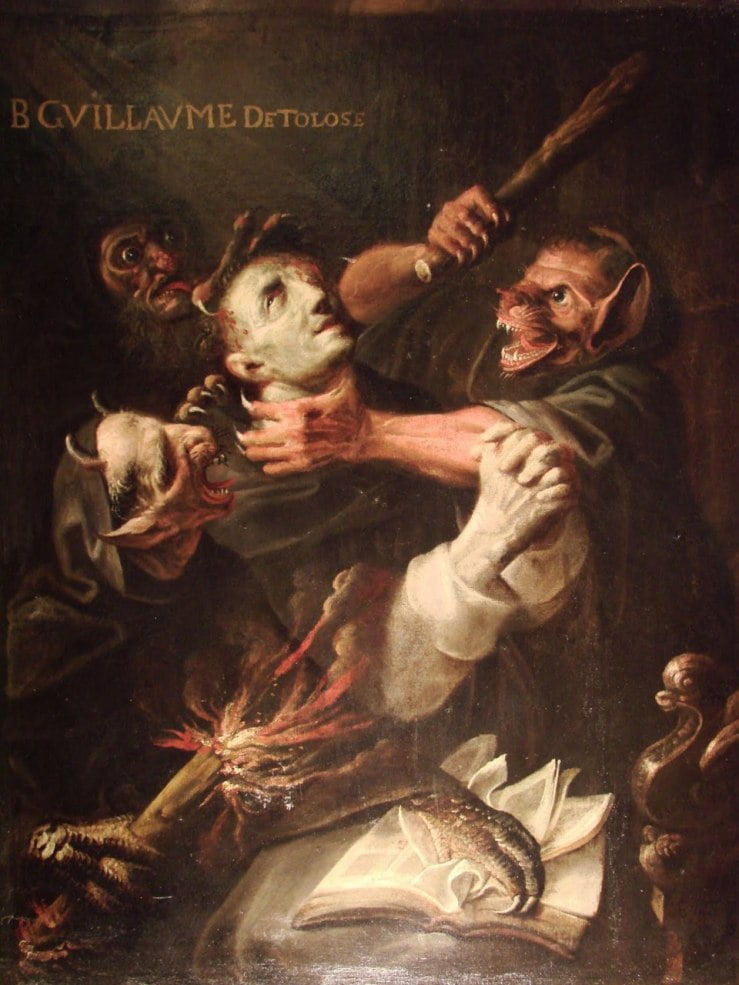
Imps are craven, but not so timid as to pass up an opportunity for a surprise attack using their invisibility and alternate form ability. In its natural form, an imp attacks with the wicked stinger on its tail. It quickly flies out of reach if a foe manages to strike back effectively.
An imp’s natural weapons, as well as any weapons it wields, are treated as evil-aligned and lawful-aligned for the purpose of overcoming damage reduction.
Poison (Ex): Injury, Fortitude DC 13, initial damage 1d4 Dexterity, secondary damage 2d4 Dexterity. The save DC is Constitution-based and includes a +2 racial bonus.
Spell-Like Abilities:
- At will—detect good, detect magic, invisibility (self only);
- 1/day—suggestion (DC 15).
Caster level 6th.
The save DC is Charisma-based.
Once per week an imp can use commune to ask six questions. The ability otherwise works as the spell (caster level 12th).
Alternate Form (Su): An imp can assume other forms at will as a standard action. This ability functions as a polymorph spell cast on itself (caster level 12th), except that an imp does not regain hit points for changing form, and an individual imp can assume only one or two forms no larger than Medium. Common forms include monstrous spider, raven, rat, and boar.

 Buy me a coffee
Buy me a coffee